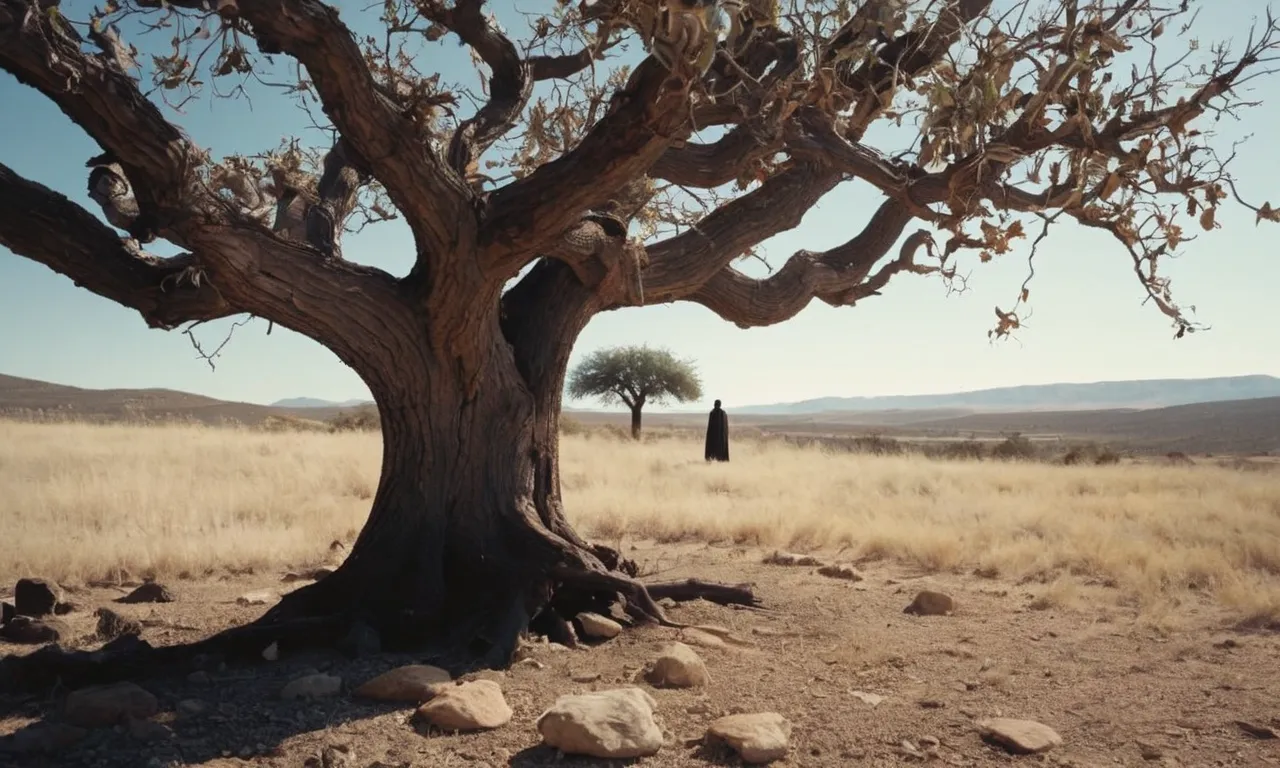Why Did Jesus Curse The Fig Tree? An In-Depth Examination
The story of Jesus cursing the fig tree is one of the more perplexing passages in the gospels. At first glance, it seems out of character for Jesus to curse a tree for not bearing fruit. However, when examined more closely, this story provides valuable insights into Jesus’s ministry and message.
If you’re short on time, here’s a quick answer: Jesus cursed the fig tree to demonstrate God’s judgment on those who fail to respond rightly to Him and His message. It served as a parable in action that revealed spiritual truths about faith, prayer, and bearing fruit for God’s kingdom.
In this approximately 3000 word article, we will take an in-depth look at the context, symbolism, and significance of Jesus cursing the fig tree in the gospels. We will examine the accounts in Matthew and Mark, explore four major interpretations, and help uncover the rich meaning of this intriguing passage.
The Biblical Accounts of Jesus Cursing the Fig Tree
The Account in Matthew 21
The story of Jesus cursing the fig tree is found in Matthew 21:18-22. Here’s a summary:
- Early in the morning, Jesus was returning to Jerusalem from Bethany. He was hungry.
- Seeing a fig tree by the road, Jesus went to it to find something to eat. But there were only leaves on the tree and no figs.
- Jesus said to the tree, “May you never bear fruit again!” And the fig tree withered immediately.
This seems like a surprising act coming from Jesus. Why would He curse a fig tree just for not having fruit when He was hungry? There may be symbolic meaning behind this account.
The Parallels in Mark 11
The story is also found in Mark 11:12-14, 20-25. Mark’s account gives more details:
- It happened during the week before Jesus’ crucifixion, when He went to Jerusalem for Passover.
- The next morning, as Jesus and His disciples passed the fig tree again, they noticed it had withered from the roots up.
- Peter pointed out the withered fig tree to Jesus, seemingly surprised.
- Jesus used the opportunity to teach His disciples about the power of faith and prayer.
So in Mark’s account, Jesus seems to use the fig tree incident more deliberately as a visual teaching illustration for His followers about spiritual truths.
Four Major Interpretations of This Passage
A Parable of Faith and Prayer
Some scholars believe the cursing of the fig tree represents a parable from Jesus about the power of faith and prayer (GotQuestions.org). The fig tree withered because the disciples lacked faith, much like some of Jesus’s followers lacked strong faith.
This passage reminds believers to earnestly pray in faith, not doubting God’s ability to answer prayers.
A Demonstration of Jesus’s Messianic Authority
Jesus cursing the fig tree demonstrated his authority and messianic power, as the Bible Study Tools website explains. His curse made the tree instantly wither, amazing the disciples. This miracle revealed Jesus’s lordship over creation, continuing his conflict with religious leaders in Jerusalem who questioned his authority as Messiah.
A Prophetic Sign Against National Israel
Some theologians, like Charles Spurgeon, saw the cursing and withering of Israel’s national symbol, the fig tree, as God judging national Israel for rejecting Jesus as Messiah. Spurgeon preached, “Did not Jesus show his displeasure against the Jewish state when he caused the fig-tree to wither away, thereby teaching that the Jewish dispensation had come to an end?”
A Symbolic Cleansing of the Temple
The CompellingTruth.org website notes that the fig tree incident follows Jesus forcefully cleansing temple courts in Jerusalem. So in this view, Jesus cursing the fig tree symbolized God’s judgment on the temple system due to rampant corruption at that time.
The day after, Jesus cursed the tree as an enacted parable against religious hypocrisy.
The Immediate Context and Location of the Fig Tree
The story of Jesus cursing the fig tree is found in two places in the Bible – Matthew 21:18-22 and Mark 11:12-14. In both accounts, Jesus and his disciples were walking from Bethany to Jerusalem just before the Passover feast.
Bethany was a small village located on the eastern slope of the Mount of Olives, about two miles east of Jerusalem. This hilly region was known for its many olive and fig orchards, so as Jesus traveled along the road, he spotted a leafy fig tree in the distance.
The fact that the tree had leaves indicated that it would likely have fruit on it. Figs normally appear on the tree at the same time as the leaves, in late March or April. Since it was springtime, Jesus would have expected to find the early fig crop on this tree.
The early figs begin to ripen in June, while the main crop is ready for harvest in August and September. So while it wasn’t unusual to find leaves on a fig tree in the spring, it was odd that there was no fruit on this particular tree.
Jesus knew that the appearance of this tree was deceptive – it looked fruitful from afar but was barren up close.
The location of this incident is also significant. Jesus encountered the fig tree just outside of Jerusalem, after coming over the Mount of Olives. He was approaching the holy city where he would soon confront the religious leaders and be crucified for the sins of the world.
The fact that the fig tree appeared healthy but lacked spiritual fruit foreshadowed what Jesus would find within the city of Jerusalem. The Jewish religious system looked dynamic and thriving from the outside, but it lacked the true spiritual fruit that was pleasing to God.
The Region’s Climate and Geography
The unique climate and geography of the Judean wilderness around Jerusalem provided optimal conditions for growing fig trees. This mountainous area experiences hot, dry summers and mild, wet winters – ideal weather patterns for the fig.
Fig trees can grow in rocky soil and can withstand drought well, thanks to their deep root systems. These hardy trees can live for over 200 years, growing to heights of over 50 feet tall and spreading their branches wide for maximum sun exposure.
The area’s elevation, rainfall, and temperature fluctuations also produce very sweet figs packed with nutrients. Judean figs were famous across the Roman empire for their rich flavor and soft texture. So encountering a fig tree near Jerusalem loaded with green leaves but lacking juicy figs would have been unexpected and disappointing.
The regions arid climate almost guaranteed a bountiful early fig harvest every spring. By all outward appearances, this fig tree seemed like it would be extremely fruitful.
The Significance of Fig Trees in Scripture
Fig Trees as Symbols of Israel
In the Bible, fig trees are often used as symbols for the nation of Israel. Here are some examples:
- In Jeremiah 24, there is a vision of two baskets of figs representing the people of Judah – one basket with good figs and one with bad figs. The good figs represented those who were obedient to God, while the bad figs represented those who were disobedient.
- In Hosea 9:10, God compares finding good fruit on a fig tree with finding obedience and righteousness among the people of Israel. Just as a fig tree should produce good fruit, God’s people should live righteously.
- In Joel 1:7, the prophet describes the judgment coming on Israel, saying that it will lay waste the fig tree, stripping its bark and destroying its branches. The fig tree again symbolizes Israel.
- In Luke 13:6-9, Jesus tells the parable of the barren fig tree. The fig tree represents Israel failing to bear spiritual fruit. Jesus says it will be cut down if it doesn’t soon produce fruit.
So in many passages, the fig tree was seen as a symbol or picture of the spiritual state of the nation of Israel. A fruitful fig tree represented times of obedience, while a barren fig tree times of disobedience and judgment.
Fruitfulness as a Sign of God’s Blessing
In the Bible, agricultural fruitfulness is often seen as a sign of God’s favor and blessing. Fig trees and their fruit are sometimes used as an example of this principle:
- In Deuteronomy 8:8, Moses describes the agricultural abundance of the Promised Land, mentioning fig trees among other fruit trees and crops. This shows how God blessed the land He was giving to His people.
- In 1 Kings 4:25, the abundance during the peaceful reign of Solomon is conveyed by saying, “During Solomon’s lifetime Judah and Israel lived in safety, from Dan even to Beersheba, each man under his own vine and his own fig tree.” Fig trees represented domestic tranquility and prosperity.
- In Zechariah 3:10, God promises that in the messianic kingdom to come, “In that day each of you will invite his neighbor to sit under his vine and fig tree, declares the LORD Almighty.” Abundant fig trees would be a sign of God’s future blessing on His people.
So fig trees were sometimes used as symbols of God’s favor, peace, and prosperity – their fruitfulness being a visible sign of His spiritual blessing. A lack of figs could suggest God had withdrawn His blessing due to the sins of the people.
Lessons and Applications for Readers
The Dangers of Hypocrisy and False Religion
Jesus cursing the fig tree was a powerful visual lesson about the dangers of hypocrisy and false religion. The fig tree looked healthy and fruitful on the outside, but it was barren on the inside. This symbolized the religious leaders and institutions of Jesus’ day that appeared righteous but were spiritually dead.
They honored God with their lips, but their hearts were far from Him (Matthew 15:8). Just like the fig tree, their outward religiosity masked inward sin and corruption. Jesus warned against hypocritical religion and taught that true, authentic faith produces spiritual fruit in a person’s life.
This lesson applies to believers today too. We must examine our own hearts and lives. Are we trusting in religious ritual devoid of true relationship with Christ? Does our faith transform our character and produce good fruit, or are we whitewashed tombs clean only on the outside (Matthew 23:27)?
If we profess faith in Jesus but lives unchanged, we are in danger of being cursed. God desires truth within the inward being, not just external religious trappings.
The Importance of Acting in Faith
The way Jesus cursed the fig tree also displays the importance of faith and prayer. Mark’s gospel records that the tree withered immediately after Jesus cursed it (Mark 11:20). But Matthew highlights that the tree did not physically wither until the next day; it was Jesus’ spoken curse that compels its demise.
This reveals the power of acting in faith before seeing results. Jesus spoke the curse believing His words would come to pass even before visible evidence. This matches Jesus’ teaching on prayer that whatever we ask believing we will receive (Matthew 21:22).
If we pray and act in confidence of God’s power, we will see His wonders.
Moreover, the fig tree illustrates that we should accept in faith what God promises, not be wavered by outward appearances. Although the fig tree appeared full of fruit from afar, upon closer inspection it was barren. God’s promises don’t always match what we see with our natural eyes.
But we must trust His word over our perceptions. If Jesus cursed the fig tree knowing it was barren despite appearances, we too must operate in faith over sight.
The Need for Spiritual Fruit in the Kingdom of God
Ultimately, Jesus cursing the fig tree demonstrates God’s expectation of spiritual fruit from His people. As a fruit tree, the fig’s purpose was to produce figs. Since it bore no fruit, it failed to fulfill its purpose and was destroyed.
Likewise, God created us to bear spiritual fruit for His kingdom. As believers grafted into Christ the true vine (John 15:1), we should produce love, joy, peace, patience, and other good fruit (Galatians 5:22-23). Only spiritual fruit brings glory to God. Religious hypocrisy is useless.
The parable of the fig tree in Luke 13:6-9 further symbolizes God’s patience for spiritual fruit that will not last forever. The owner waits 3 years for the barren fig tree to produce fruit before cutting it down.
So too God patiently gives us time to bear fruit, but judgment will come to fruitless religious hypocrites. We must urgently examine our lives and repent of fruitlessness. The ax is already laid at the root of trees without good fruit (Matthew 3:10).
Our faith must manifest itself in action (James 2:14-26). We are saved to serve God and build His kingdom.
Conclusion
In conclusion, the story of Jesus cursing the fig tree has profound implications for readers. More than just a random act of frustration, it served as a parable in action. It revealed vital spiritual truths about responding rightly to God, exhibiting true faith, and bearing fruit.
As we have seen, the fig tree represented Israel, who despite an appearance of fruitfulness, failed to truly know God. The lesson for us is to ensure we are not merely religious hypocrites but have a real and living faith producing spiritual fruit.
If we truly abide in Christ, we will bear fruit that will last. The alternative is to face the righteous judgment of God, like the cursed fig tree that withered away. May this peculiar passage motivate us to evaluate our lives and live fully for God’s glory.








